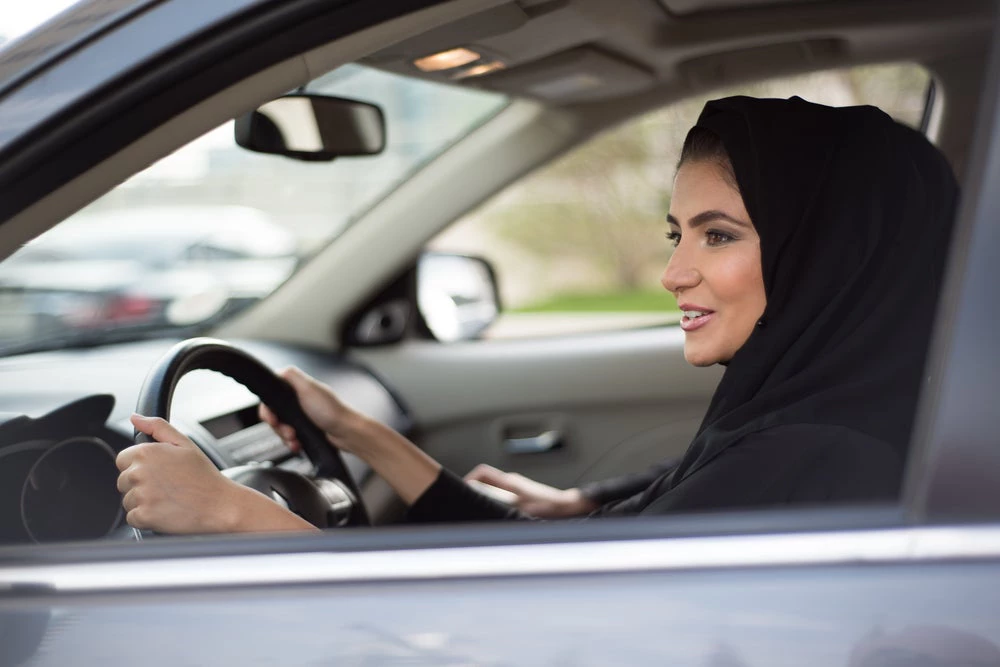 Woman driving car in the Arabworld. (Shutterstock.com/Feroze Edassery)
Woman driving car in the Arabworld. (Shutterstock.com/Feroze Edassery)
When it comes to issues of women’s empowerment, the Middle East & North Africa (MENA) is heavily scrutinized. Within it, paradoxes abound: Although ranking highest for women in tertiary education, it is also the lowest in terms of their participation in the labor force. The International Monetary Fund (IMF) estimates a 20% to 40% gain in per capita GDP if women throughout MENA participated fully in economic activities . It says Egypt alone would see an estimated increase of 34% if female labor force participation rates matched that of male.
The data seems clear: despite MENA's ratio of 106% of women to men in tertiary enrollment, and even higher in Algeria (at 166%), a regional average of about 80% of women remain outside the labor force , a paradox that can be explained by a number of social factors, such as women’s limited mobility and harassment or threats to their safety in public places. The limitations facing women constrain economic growth.
The lifting in June 2018 of the decades-old ban on women driving in the Kingdom of Saudi Arabia was heralded as a new dawn for women’s autonomy. Yet, challenges to gender parity remain and—particularly during this COVID-19 pandemic, where women have been more exposed to layoffs given the nature of their roles and status in the labor force—having the option of using affordable, safe, and reliable urban transport is considered essential to achieving it. This is because, until now, urban transport has been the backbone of urban economic development and, within it, women’s mobility a key enabler to their gaining access to jobs, education, health services, and social and political participation.
New patterns of work may yet change the labor force patterns that have been intimately connected to commuting behavior. For now, though, just as the availability of employment can shape a commute, the lack of commuting options can affect your participation. And mobility patterns differ significantly for women and men: In Jordan, a full 40% of women are said to have turned down employment opportunities for lack of access to viable transport. In Egypt, Morocco, Tunisia, Lebanon, and Jordan at least 65% of women expressed feeling insecure or cited experiences of violence or harassment—or their fears of it—as reasons for not using a public transport system.
Cost is a factor, too. On average, women in MENA earn less than men, often due to the nature of jobs available to them. Economic returns do not always justify their use of expensive, sometimes unreliable public transport systems for commuting from home to work and back. A safe, sustainable, efficient, and affordable urban transport system would make it easier to combine the conflicting demands made on women’s time—and thus unleash their economic inclusion. Understanding the trends in female labor force participation is essential to devising gender-sensitive policies to increase women’s involvement in the economy.
Having a Sustainable Urban Mobility Plan could make public transportation attractive and customer-centric, providing safety, security, reliability, and affordability, in particular for women. But it must be able to compete with the flexibility and comfort of the private car and provide users a positive experience in order to encourage women customers of different ages and socio-economic status to use public transport as the commute of their choice.
There is a radical shift in the range of mobility available, from e-bikes and e-scooters to shared autonomous vehicles and electrified transport systems. In Cairo today, women see bikes and scooters as the fastest, most affordable ways to manage the city’s chaotic traffic. And, when it comes to scooters, they are willing to spend as much as US$112 to learn how to ride them.
Ultimately, the benefits of greater participation of women in MENA’s economies depend not just on transport but on other factors, including a change in attitudes. The role of governments is to foster an enabling environment and build the right sort of infrastructure needed to drive this change.
Jordan’s Ministry of Transport is asking stakeholders in the transport market to sign a Code of Conduct—a move aimed at addressing some of women’s public safety and security concerns. This idea, conceived as part of the World Bank’s Jordan Equitable Growth and Job Creation project, is an initiative that could be replicated across the region. Others include employing more women in urban transport; developing gender-responsive infrastructure and services; enforcing safe-driving rules; training public transport employees; and implementing a proper reporting and grievance system for victims of transgression or abuse.
While passing laws that punish harassment and protect women are important, enforcing them is even more so. Women in Casablanca and Algiers are said to prefer the metro or tram to the bus because the presence of police and other security personnel in metro and other stations can protect them. The private sector, too, can anticipate changes in consumer demand: Uber’s Women Preferred View in Saudi Arabia helps passengers choose a woman driver. But, where women drivers are not available, adding panic buttons to smartphone apps would give women the confidence to know they could report harassment easily with a tap of their phone. Such proactive measures are needed to bridge the gender divide.



Join the Conversation